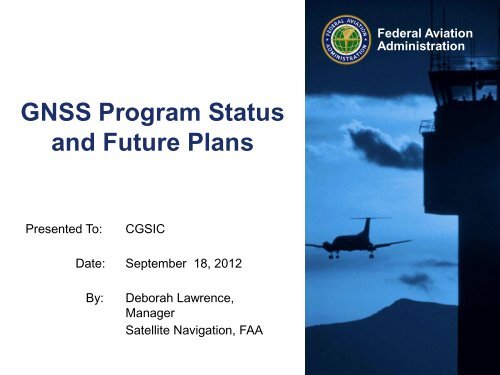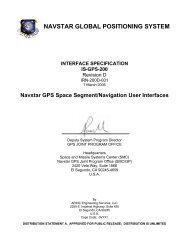2 MB PDF - GPS.gov
2 MB PDF - GPS.gov
2 MB PDF - GPS.gov
Create successful ePaper yourself
Turn your PDF publications into a flip-book with our unique Google optimized e-Paper software.
CGSICSeptember 18, 2012Federal AviationAdministration2
Wide Area Augmentation System - 200338 ReferenceStations3 MasterStations6 GroundEarth Stations3 GeostationarySatellite Links2 OperationalControl CentersCGSICSeptember 18, 2012Federal AviationAdministration3
WAAS Phases• Phase I: IOC (July 2003) Completed– Provided LNAV/VNAV/Limited LPV Capability• Phase II: Full LPV (FLP) (2003 – 2008) Completed– Improved LPV availability in CONUS and Alaska– Expanded WAAS coverage to Mexico and Canada• Phase III: Full LPV-200 Performance (2009 – 2013)– Development, modifications, and enhancements to include tech refresh– Steady state operations and maintenance– Transition to FAA performed 2nd level engineering support– Begin <strong>GPS</strong> L5 transition activities• Phase IV: Dual Frequency (L1,L5) Operations (2014 – 2028)– Complete WAAS transition from L2 to L5– Commence dual-frequency, iono-free service• Improved availability and continuity, especially during severe solar activity– Maintain single frequency SBAS service– Other capabilities under consideration (see Technology Evolution slide)CGSICSeptember 18, 2012Federal AviationAdministration4
ApproachDevelopmentGEO SchedulePhasesWAAS Enterprise ScheduleFY98 99 00 01 02 03 04 05 06 07 08 09 10 11 12 13 14 15 16 17 18 19 20 21 22 23 24 25IOC (Phase I)DevelopmentOperationalFLP (Phase II)LPV-200 (Phase III)DevelopmentFOCOperationalTechnical RefreshOperationalDual Frequency (Phase IV)JRCJRCTechnical RefreshOperationalGEO #1 – AOROperationalReplaced by GEO #3Initial GEOsGEO #2 – POROperationalReplaced by GEO #4GEO #3 – Intelsat (CRW)GEO #4 – TeleSat (CRE)Launch 10/05CRW Powered DownOperationalOperationalCRW Comm Loss CRW ReacquiredOperationalLaunch 9/05Gap Filler GEO (AMR)OperationalLaunch 09/08GEO #5 – TBDOperationalLaunch 2015GEO #6 – TBDOperationalLaunch 2018GEO #7 - TBDOperationalLaunch 2018WAAS ProcedureDevelopmentLP/LPV procedures aredouble that of ILS as ofJune 2011Currently 3289~5,218
Current Activities• Ground Segment– Safety Computer• Processor throughput and obsolescence• Contract awarded June 2012• Expect to integrate into baseline ~2016-2018– Software Development• Release 3B Cutover September 10, 2012• Release 4 (Software Build Merge and CodeCleanup)– Projected complete September 2013– GIII Receiver Development• Adds L5, L1C and L2C tracking capabilities• Prototype Testing in Progress– Comm Upgrade• Planning efforts underway to supportadditional bandwidth and data associated withDual-frequency WAAS– Dual-Frequency Capability• Continuing algorithm development• Capability follows L5 IOC (L5 IOC expectedaround 2019)• Current WAAS GEO satellites– Intelsat Galaxy XV (CRW)– Anik F1R (CRE)– Inmarsat I4F3 (AMR) *• GEO 5/6/7– SIR package released December2011– Anticipated contract awardSeptember 2012CGSICSeptember 18, 2012Federal AviationAdministration6
WAAS Reference Receiver (G-III)• WAAS program developing next generation reference receiver(G-III)• G-III receiver will add significant new capability and supportWAAS dual frequency upgrades in 2014 – 2019 timeframe– Tracks up to 18 <strong>GPS</strong> satellites and 8 SBAS satellites– Capable of tracking <strong>GPS</strong> L1C/A, L1C, L2C, L2 P(Y), and L5 signal types– Expandable to support additional GNSS signals in the future• Current Status– Test Readiness Review completed end of August– Software Development and Hardware Development Completed– Testing expected to begin in October• Development currently scheduled to becomplete in FY2013– ~14 Production Receivers• Follow-on contract for productionreceivers expected 3 rd Qtr FY13– ~165 Production ReceiversCGSICSeptember 18, 2012Federal AviationAdministration7
WAAS Safety Computer• The SC adds significant new capability andsupport to WAAS dual frequency upgrades– The SC will be capable of hosting either WAAS MasterStation (WMS) application or the GEO Uplink Station(GUS) without changing the WAAS SC hardware orInfrastructure of software• WMS type SCs– Validate corrections messages generated by DO-178BLevel D assured software in the WMS CorrectionProcessors (CPs)– Preclude broadcast of Hazardously MisleadingInformation (HMI) to WAAS users• Current Status– Preliminary Design Review, September 2012– Critical Design Review, December 2012– Testing expected to begin in June 2013• Initial Production SC currently scheduled tobe complete in FY2013– ~28 Production Safety Computers• Follow-on contract for production SC•SC Conceptual Design: RearviewCGSICSeptember 18, 2012Federal AviationAdministration8
WAAS LPV CoverageCGSICSeptember 18, 2012Federal AviationAdministration9
Airports with WAAS LPV/LP InstrumentApproachesAs of August 23rd, 2012- 3,289 LP/LPVs combined- 2,941 LPVs serving 1,482 Airports- 684 LPV-200’s- 1,896 LPVs to Non-ILS Runways- 1,045 LPVs to ILS runways- 1,257 LPVs to Non-ILS Airports- 348LPs serving 252Airports- 343 LPs to Non-ILS Runway- 5 LPs to ILS RunwaysCGSICSeptember 18, 2012Federal AviationAdministration10
WAAS Avionics Status• Garmin:– 75,833+ WAAS LPV receivers sold– Currently largest GA panel mount WAAS Avionics supplier– New 650/750 WAAS capable units brought to market at the end of March 2011 to replace 430/530W units• AVIDYNE & Bendix-King:– 140 Avidyne Release 9 units sold to date. Introduced IFD540 FMS/<strong>GPS</strong>/Nav/Com System with Touch screen– Bendix King KSN-770 certification pending• Universal Avionics:– Full line of UNS-1Fw Flight Management Systems (FMS) achieved avionics approval Technical Standards OrdersAuthorization (TSOA) in 2007/2008– 2,400+ WAAS receivers sold as June 2, 2012,• Rockwell Collins:– Approximately 2,700 WAAS/SBAS units sold to date• CMC Electronics:– Achieved Technical Standards Orders Authorization (TSOA) certification on their 5024 and 3024 WAAS Sensors– Convair aircraft have WAAS LPV capable units installed (red label) and expect WAAS LPV certification by August2012– Canadian North B-737-300 obtained STC for SBAS(WAAS) LPV using dual GLSSU-5024 receivers• Honeywell:– Primus Epic and Primus 2000 w/NZ 2000 & CMC 3024 TSO Approval– Primus 2000 FMS w/CMC 5024 TSO pendingCGSICSeptember 18, 2012Federal AviationAdministration11
WAAS STC Aircraft August 2012 (Estimate)• Garmin – 56,612 aircraft– Covers most GA Part 23 aircraft.– See FAA Garmin Approved Model List (AML)• http://rgl.faa.<strong>gov</strong>/Regulatory_and_Guidance_Library/rgstc.nsf/• Universal Avionics – 1,531 aircraft– 120 fixed wing types and models– 12 helicopter types and models– Airframes to include (Boeing, de Havilland, Dassault, Bombardier,Gulfstream, Lear, Bell, Sikorsky, etc…)• Rockwell Collins – 950 aircraft– 32 types and models– Airframes to include (Beechjet, Bombardier, Challenger, Citation, Dassault,Gulfstream, Hawker, KingAir, Lear)• Honeywell / CMC Electronics – 346 aircraft– 16 types and models– Airframes to include (Gulfstream, Challenger, Dassault, Hawker, Pilatus,Viking)• Avidyne – 175 aircraft– 3 types and models (Cirrus, Piper Matrix, and EA-500)• Cobham (Chelton) – 200 aircraft– 4 types and models (Bell-407, Bell -412, Cessna 501, 550)• Thales – Airbus 350 certification pendingCGSICSeptember 18, 2012Federal AviationAdministration12
GBAS (Ground Based Augmentation System)CGSICSeptember 18, 2012Federal AviationAdministration13
FAA GBAS Program• The FAA has indefinitely delayed plans for GBASacquisition• The FAA GBAS program focuses on three taskareas:– GAST-D ICAO SARPs validation• FAA CAT III activities focus on single frequency <strong>GPS</strong>augmentation requirements• Produce an commercial prototype for validation testing– Vendor could seek NonFed approval– RFI analysis and mitigation– Limited CAT I implementation support• Newark NJ and Houston TX operational approval support• Gain operational experience with GBASCGSICSeptember 18, 2012Federal AviationAdministration14
GBAS at Newark•GBAS location andPPD Jammer example•GBAS locationCGSICSeptember 18, 2012Federal AviationAdministration15
CAT III (GAST D)Technical Update• FAA executing two GBAS CAT III contracts (Groundand Avionics)– Prototype ground system based on the SLS-4000• Includes a recent modification for robust RFI modifications– Prototype avionics system based on the Honeywell IntegratedNavigation Receiver (INR)• Validation is the key product– Finding and reporting requirements interpretation issues orpotential interoperability problems– Analyzing fault-free performance to determine realisticthresholds– Includes comparisons to FAA baseline equipmentCGSICSeptember 18, 2012Federal AviationAdministration16
FAA GBAS Project ScheduleOct 11 Nov 11 Dec11 Jan12 Feb12 Mar12 Apr12 May12 Jun12 Jul12 Aug12 Sep12 FY13 FY14 FY15 FY16CAT III ValidationGroundGround System Prototype developmentCAT III RFI mitigation GroundNon FederalApprovalCAT III ValidationAvionicsAvionics Prototype developmentRFI Mitigation*Technical Support<strong>GPS</strong> RFI Detection System Feasibility<strong>GPS</strong> RFI Detection SystemPrototype OperationsCAT I Block 1System DesignApprovalCAT I NewarkImplementationCAT I HoustonImplementationRFI Mitigation Review, Siting ChangesSoftware and HMI ApprovalCAT I preliminary siting changesRFI data collectionCivil works/InstallationCompleted/startedProcedures/Flight InspectionPlannedSiting/Installation updatesOps ApprovalDelayedOps ApprovalCGSICSeptember 18, 2012Federal AviationAdministration17
Federal Register Notice (76 FR 77939)• Published December 15, 2011• FRN stated that the FAA:– Transitioning to a Performance Based Navigation (PBN) system– Transitioning from airways defined by legacy NAVAID systems to NAS basedArea Navigation (RNAV) and Required Navigation Performance (RNP)• Legacy NAVAIDs are identified as VHF Omini-direction Range (VOR), Tactical AirNavigation (TACAN) Azimuth, VOR/TACAN (VORTAC), VOR/DME and Non-Directional Beacon (NDB)• Distance Measuring Equipment (DME) stations and a minimum operational network(MON) of VOR stations will remain in place to ensure safety and continuousoperations for high and low altitude en route airspace over the conterminous US(CONUS) and terminal operations at the Core 30 airports• The FAA is also conducting research on Alternate Positioning, Navigation andTiming (APNT) solutions that would enable further reduction of VORs below theMON.– Satisfy any new requirements for Category I instrument operations with WAAS localizerperformance with vertical guidance (LPV) procedures.• A network of existing Instrument Landing Systems (ILS) would be sustained to provideapproach and landing capabilities during <strong>GPS</strong> outages.CGSICSeptember 18, 2012Federal AviationAdministration18
VOR Minimum Operational Network(MON)• FAA announced plans to reduce the Very High FrequencyOmnidirectional Range (VOR) based navigation network to providean alternate means of navigation in case of <strong>GPS</strong> outage called theMinimum Operational Network (MON) project– Projected full functionality by 2020• Key elements of the project:– Minimum network of VORs that will support VOR to VOR navigationand proceeding to airports with Instrument Landing System (ILS) orVOR approach procedures.– The reduction in the number of VORs in the NAS.– Coverage above 5,000 ft Above Ground Level (AGL) in the continentalUS (CONUS) for navigation.– Support international arrivals and departuresCGSICSeptember 18, 2012Federal AviationAdministration19
VOR MON (Cont.)• The MON will permit non-GNSS guidance to an airport within 100nautical miles (nm) that has an ILS or VOR approach procedure.– Aircraft will be able to navigate at or above 5,000 ft AGL and to an airportwithin 100 nm and land at that airport using non-GNSS-based landing aidssuch as an ILS or VOR.– Automatic Direction Finding (ADF), Distance Measuring Equipment (DME)and ATC Vectors will not be required to fly an approach at the identifiedairports• All VORs will be retained in Alaska, the Western U.S. MountainousArea (WUSMA), and U.S. Islands and territories• Total Number of VOR’s to remain is approximately 497– Western US Mountainous Area (232), Alaska (40), Hawaii (11), PuertoRico and U.S. Virgin Islands (6), Guam, Samoa, and Grand Turk (1 each)(3), International Routes [Atlantic and Pacific] (20), Support for ILSapproaches (192), Support for VOR approaches (57)CGSICSeptember 18, 2012Federal AviationAdministration20
Alternative Positioning, Navigation &Timing (APNT)• The transformation of the National Airspace System to the NextGeneration Air Transportation System dependent on the availability of<strong>GPS</strong>-Based PNT services and suitable alternate PNT services– RNAV and RNP procedures for trajectory-based operations (TBO)– Current ATC system cannot be scaled up to handle 2X traffic– 2X traffic is more than a controller can handle using radar vectors– Procedural separation with Conformance Monitoring will separate aircraftperforming trajectory based operations (TBO)– Controllers intercede to provide “control by exception”• TBO Operations may require PNT performance that exceedsDME/DME/IRU• <strong>GPS</strong> vulnerability to radio frequency interference (RFI) requiresmitigation– Waiting for the source of the interference to be located and turned off is not anacceptable alternativeCGSICSeptember 18, 2012Federal AviationAdministration21
APNT Background• Maintain Safety and Security while minimizing economic impactsduring <strong>GPS</strong> interference• The legacy navigation and surveillance systems are not capable ofmeeting the PNT performance requirements necessary to avoidsignificant disruption and loss of capacity and efficiency benefitsduring a <strong>GPS</strong> outage.– VORs and NDBs cannot support RNAV/RNP– Estimated increases in traffic by 2025• Support NextGen operational improvements during a <strong>GPS</strong> outage– TBO, RNAV/RNP, and Performance Based Navigation• Performance Requirements to support performance based navigation– En-route 5nm, Terminal 3nm– Zones 1 En-route High (FL180 ~ FL600)– Zone 2 En-route Low (5,000 AGL ~ FL180)– Zone 3 Terminal (135 Candidate Airports)CGSICSeptember 18, 2012Federal AviationAdministration22
APNT Alternatives• Leverage existingtechnology and system• Least Impact onAvionics• Evaluating technologyopportunities• Aircraft Uses Own-shipPosition for Navigation• Potential leverage ofplanned and existingtechnology and groundinfrastructure• Some impact on Avionics• Unlimited Capacity• No existing FAAStandards• Highest impact onAvionics• Longest lead time inimplementationCGSICSeptember 18, 2012Federal AviationAdministration23
Summary• WAAS Phase 3 Development Completed• WAAS Continues Development Activities for DualFrequency Upgrade to Align w/<strong>GPS</strong> Modernization• GBAS Cat-I System Design Approved• GBAS Cat-II/III R&D Underway• Federal Acquisition of GBAS On Hold• VOR Sites to be Divested Currently being Identified• Ongoing talks between DoD and FAA concerningTACAN sustainment• FAA Assessing Alternatives for Alternate PNTCGSICSeptember 18, 2012Federal AviationAdministration24
QuestionsCGSICSeptember 18, 2012Federal AviationAdministration25
Project Newark• History– Newark GBAS installed November 2009, owned by the Port Authority of NewYork/New Jersey (PANYNJ)– RFI detected during installation testing– Determined to be mobile Personal Privacy Devices (PPDs)• Solutions– Software and siting modifications developed to provide safe and continuousoperation when PPDs present– Modifications required a new System Design Approval (SDA) for the SLS-4000• Activities– SRMD Panel meeting for the update (Block I) was completed– PANYNJ completed site modification work June 18– FAA conducted an additional flight inspection; periodic check passed– PANYNJ requested a 1000hr verification test prior to operational approval• More that 2000 hours had been prior to July without RFI interruption• Several outages occurred in July, suspected RFI source violated siting assumptions, enforcementaction was taken• Expected Outcome– Operational Approval at Newark prior to September 30, 2012CGSICSeptember 18, 2012Federal AviationAdministration26
Project Houston• History– FAA SATNAV team decision to provide a GBAS at Houston yielding a city-pairfor GBAS operations– Plan included moving Memphis GBAS to Houston, development of advanceprocedures, and simulation testing• This is a non-Fed GBAS installation owned by the Houston Airport System• Activities Completed– Remove system from Memphis, GBAS factory refurbishment, site studiesincluding RFI testing, installation, site acceptance testing, flight inspection,non-fed coordinator training, predictive tool training, SDA revision• Modification to the System Design Approval (SDA) was addressed aSignal Distortion Monitor (SDM) integrity issue– Some receiver designs allowed within the standards (MOPs, SARPS, TSO)were not protected• A new Safety Risk Management Document (SRMD) was required– Director of Enterprise Services (AJM-3) is approved the document on June 7 th .• Currently awaiting Operational Approval (was expected May 31,2012)CGSICSeptember 18, 2012Federal AviationAdministration27
CAT III Funding Issue• Due to funding cuts in FY12, VHF data broadcast(VDB) validation work can not be completed asplanned– Work included testing and analysis to determine if the currentCAT I VDB configuration can provide sufficient coveragethrough touchdown and rollout– Shortfall was identified at RTCA as well as at ICAO and here atthe IGWG• Develop a plan through those groups to identify an alternatevalidation strategyCGSICSeptember 18, 2012Federal AviationAdministration28
NextGen APNT RoadmapCGSICSeptember 18, 2012Federal AviationAdministration29
Pseudolite Technologies• APNT can use existingsystems + new avionics• DME PL+UAT PL can usesingle antennaDME (RNAV)Enhanced978-1215 MHzDME PL978-1215 MHzSM PL960-977 MHzUAT (PL)978 MHzDMEGround BasedTransceiversCGSICSeptember 18, 2012Federal AviationAdministration30
Combined Network ofDMEs and GBTsDME’s ~1100GBTs ~ 800CGSICSeptember 18, 2012Federal AviationAdministration31
USAF Ultra High AccuracyReference System (UHARS)• USAF 746 Test Squadron Non-<strong>GPS</strong> Based PositioningLocata System• Testing at White Sand Missile Range (WSMR) with <strong>GPS</strong>jamming over 2,500 sq. miles– Solution 1: Satellite-based synchronization• One or two master PLs for entire network• No ground-based line-of-sight required,since satellite is always visible• Potential for additional navigation signalat aircraft•?•receiver•LL 5 •LL 4•Satellite•LL 3•LL 2•LL 1– Solution 2: Land-line-based synchronization• One or more nationwide master nodes• Fiber-optic or other signals for timesynchronization• No single point of failureCGSICSeptember 18, 2012Federal AviationAdministration32
TACAN Issue• FAA in the process of implementing a “reduced service” programfor Very High Frequency Omnidirectional Range (VOR’s)• Currently 575 FAA owned an maintained VOR’s collocated withTactical Air Navigation (TACAN)• Decreased commercial and civil requirements for VOR’s resulted insignificantly limited funding for FAA to support VORTAC(VOR/TACAN) sites• April 5 th , 2012 Teri Bristol (FAA VP Technical Operation Services)delivered a letter to Steven Pennington, Executive Director DoDPolicy Board on Federal Aviation– Letter stated that “Effective immediately if a TACAN system is currently out ofservice, it will no be repaired or returned to service.”– However if a Distance Measuring Equipment (DME) is collocated at a TACAN,that function will be restored by the FAA– If the DoD required selected TACAN’s to be repaired/restored the FAA’s NASDefense Program (NDP) would transfer funding to the DoD to effect repairsCGSICSeptember 18, 2012Federal AviationAdministration33
TACAN Issue (Cont.)• June 2, 2012 Steven Pennington responded to the FAA letterconcerning the FAA’s position on TACAN drawdown• DoD identified (49 U.S.C. § 44505) that the FAA “has thestatutory responsibility to meet the needs for safe andefficient navigation and traffic control of civil and militaryaviation.”– The letter went on to state that FAA has been provided funding byCongress to provide these services to DoD when the DoD operates“similar to civil traffic.”• DoD stated the implementation of a new advanced operationor the removal of compatible NAVAIDs as discussed in FAA’sNextGen Transition to Performance Based Navigation do notmeet the requirements of determining the operationalrequirement of a NAVAIDS continued operation andmaintenance.• Ongoing coordination between DoD and FAA continuesCGSICSeptember 18, 2012Federal AviationAdministration34
Mitigations and Tests Completed• Test plan developed to assessimpact of proposed mitigations.• Test configuration differed fromproposed configuration to limitcost and airport changes duringtest period2) Antenna Raising(RFI Rejection)1) RFI SW Robustness Upgrades4) Spatial De-correlation3) Antenna Loweringand Physical BarrierCGSICSeptember 18, 2012•35Federal AviationAdministration35


